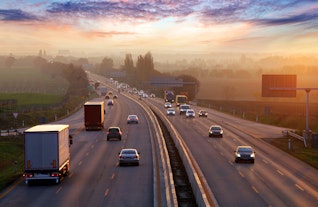The race is on. Science says we must cut emissions to net zero by 2050 if we are to avoid the most severe impacts of climate change. And the world will most likely hit an average temperature of 1.5 degrees Celsius above preindustrial levels sometime in the next five years.
Clearly, there is no time to waste in decarbonising our economy. But which sectors are leading the way on this in the UK? Here are five that are making strides—although there is no quibbling over the fact that there is still a long way to go.

Electricity
UK electricity used to come from burning coal, but today the black is turning green. Wind power, mostly from offshore projects, overtook natural gas to be the UK’s main source of grid power for the first time ever in the first quarter of 2023.
Although gas still meets up to around half of all grid power on occasions, its rise has recently been mostly at the expense of coal, which has virtually disappeared from the generation mix.
Since gas has a lower carbon footprint than coal, this substitution, along with the buildout of offshore wind, has helped bring down electricity system emissions significantly in recent years.
The carbon intensity of UK electricity production fell 44% between 2000 and 2022, from 485 to 268 grams of carbon dioxide per kilowatt-hour. At the end of May 2023, it was hovering at around 120 grams per kilowatt-hour.
This level will doubtless drop further as renewable energy penetration grows in the grid, aided by a massive buildout of battery storage from projects such as Richborough Energy Park.
Construction
The UK’s built environment is responsible for a quarter of the country’s greenhouse gas emissions, mainly because of the energy required for producing materials such as steel, cement and concrete.
These materials industries are hard to abate but in recent years there has been growing momentum behind the development of more sustainable construction practices.
One example is the rise of so-called modern methods of construction (MMC), which typically focuses on off-site production and factory assembly of building components such as walls and panels.
MMC is more efficient than traditional building practices and allows new, lower-emissions materials to be more easily integrated into the construction process. Benx is an example of a British company using MMC principles to make building facades.
Another development is the rise of low-emissions variants of traditional building materials and components. The Scottish startup Kenoteq, for example, has created a brick that is made from almost 100% recycled content and has only 5% of the carbon footprint of traditional bricks.
While such companies address the embedded carbon in buildings, the use of technologies such as solar panels, batteries and heat pumps can help reduce building emissions after construction.

Automotive
Road transportation is a major contributor to UK greenhouse gas emissions, but the sector is on course for decarbonisation thanks to increases in the efficiency of internal combustion engine cars and the rise of electric vehicles (EVs).
These still only make up a tiny proportion of UK vehicles, with electricity accounting for less than 0.2% of the energy used in road transportation in 2021.
However, EV sales are expected to rise to almost 64 million units by 2027, an increase that will require massive investments in charging infrastructure and associated battery storage, along with renewable generation from solar canopies and similar structures.
The switch to electric will have a significant impact on automotive emissions since the largest part of a car’s greenhouse gas footprint comes from the fuel it consumes while in use.
Today, EVs are not entirely carbon-free because their manufacturing results in emissions and if they draw electricity from the grid then their greenhouse gas footprint will mirror that of the electricity network.
However, research in 2020 showed the lifetime emissions for a UK EV would be 30% less than those of an internal combustion engine model… and the grid is greener now than it was three years ago.
Manufacturing
UK manufacturers have a strong incentive to reduce their emissions because a large part of manufacturing costs tend to be associated with energy use, and particularly fossil fuels.
The recent rocketing costs of gas and electricity have encouraged many British manufacturers to introduce energy-saving measures and buy green electricity through power purchase agreements.
According to a 2022 poll by the industrial giant Siemens, eight out of 10 manufacturers say decarbonisation is a high or medium priority, and 46% have implemented low-carbon strategies.
Not all manufacturers will find it easy to reduce their carbon footprints, because industries such as steelmaking rely on fossil fuels not only for power but also as a feedstock.
However, there are growing moves to create alternative manufacturing pathways that rely more on electricity and low-carbon fuels such as green hydrogen.

Agriculture
Agriculture, forestry and fishing has the highest greenhouse gas intensity of any UK business sector, in terms of tonnes of carbon dioxide per pound of gross added value to the nation’s economy, according to figures from the consultancy group McKinsey & Company.
This means the sector also has one of the biggest potentials for reducing the UK’s overall carbon footprint, albeit that the task is not easy.
Since 1990, agricultural emissions have dropped by 12%, based on government data, and the government’s Net Zero Growth Plan of April 2023 aims to increase that level through measures such as livestock food additives, carbon audits and agroforestry.
Pressure groups such as WWF are concerned the measures may not go far enough but the fact remains that UK farmers control several important decarbonisation levers.
One is the way in which livestock are maintained, and the extent to which they are farmed, since meat production carries a high carbon footprint.
Another is in the way land is managed, since planting trees and practicing regenerative farming techniques can help farmland absorb large amounts of atmospheric carbon dioxide.
Finally, farmers that fancy an extra revenue stream can lease out their land for the construction of wind farms, solar plants and battery projects.
Publish date: 26 September, 2023